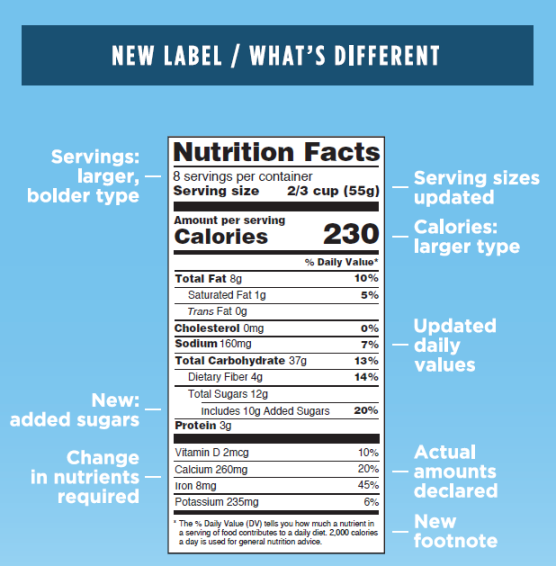Consumers now, more than ever, are increasingly educated about the products they buy. Technology and connectivity have enabled consumers to research everything from sofas to sodas before making the final decision to purchase. Companies have started to respond to customers’ need for information by supplying them with detailed product descriptions and more transparency behind their product than ever before. Food and beverage manufacturers are no different.
More and more, we are seeing products hit the shelf with new, ‘healthy’ ingredients to earn consumer trust and help them feel more comfortable serving the products to their families. Not only have food manufacturers implemented changes to please consumers, but the FDA has thrown their hat in the ring as well.
Starting in 2020, the FDA is mandating a new nutrition label law that will provide consumers with straightforward information about the ingredients and nutritional value of their favorite food products. These updates aim to increase consumer awareness and educate them on the choices they make regarding portion sizes.
What’s New In 2020 – Nutrition Labels

While the overall look of the nutrition labels will remain the same, many changes are being made to the information itself. The most impactful will be the updated serving sizes and addition of calling out included added sugars. Serving sizes are being changed to reflect more ‘realistic’ expectations of what we eat. For example, ice cream had a 1/2 cup serving size, and will now have a 2/3 cup serving size, soda will now have a 12 oz. serving size. Along with the increases in serving sizes, packages with ‘odd’ sizes (in between single serving and family size) will have nutrition labels that reflect the nutritional information for eating the whole container…as most of us are guilty of doing.
As for added sugars, they will be visible as a separate sub-line of total sugars. There are naturally occurring sugars in many foods, however the amount of added sugars in our food is ever increasing. This new line will call out these unhealthy additions we so easily disregard. These two updates alone will enable consumers to be more educated about the dietary choices they are making.
The new nutrition label design will be implemented in stages, to give smaller manufacturers time to update. Companies making over $10 million a year will be required to have the new label starting January 1, 2020, whereas those making less than $10 million will have until January 1, 2021.
Guidance for Consumers
Although the updates are meant to directly benefit consumers, for some, these changes can be intimidating. The FDA plans to assist consumers by helping them to understand what the new nutrition labels mean. In a statement from FDA Commissioner Scott Gottlieb, M.D., the FDA’s plan was clearly outlined:
“We’re also going to be launching an educational campaign to help Americans use the new version of the Nutrition Facts label and interpret the overall nutritional content of products they find on supermarket shelves. This opportunity will allow us to reach consumers directly through educational videos, social media campaigns and user-friendly websites to help them discern the relationship between the dietary choices they make every day and the impact those choices can have on their own and their family’s health.”
This campaign is designed to enhance the consumer experience of selecting food products, helping shoppers utilize these new labels to their fullest. At The Martec Group, we have tracked many food and beverage industry changes and regulations before, but we anticipate these new label laws will prove to have a more direct impact on consumers than what we’ve seen before. As this program rolls out, we will be excited to see how consumers react!
Want more? Contact us for a case study.




